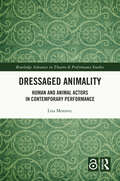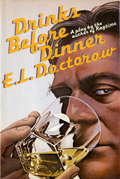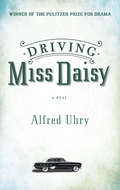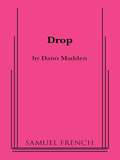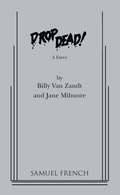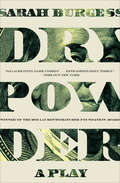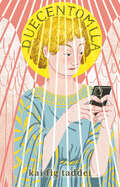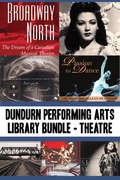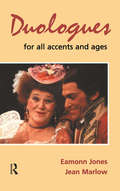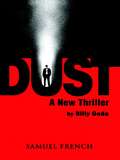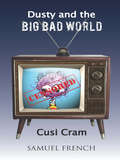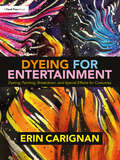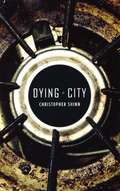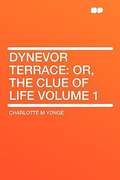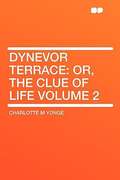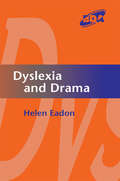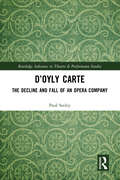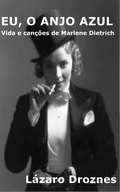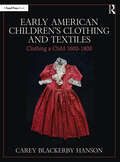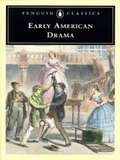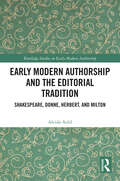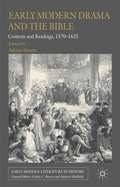- Table View
- List View
Dressaged Animality: Human and Animal Actors in Contemporary Performance (Routledge Advances in Theatre & Performance Studies)
by Lisa MoravecThe book applies a productive interdisciplinary lens of art history, performance, and animal studies for approaching political economy issues, critiquing anthropomorphic worldviews, and provoking thoughts around animal and human nature that spark impulses for an innovative performance aesthetics and ethics.It combines Marxist analysis with feminist and posthumanist methodology to analyse the relation between ‘societal dressage’ and ‘bodily animality’ that humans and animals share. Within this original theoretical framework, the book develops the concept of ‘dressaged animality’ as a mode of critique to analyse the social and political function of interdisciplinary forms of ‘contemporary performances.’Drawing on archival and primary research, the book theorises and historicises more than 15 performance practices in which animality is allegorically staged through by humans danced, real, or filmically mediated animals. It focuses on Rose English’s pioneering approach to performance-making as well as on overlooked performances by other renown and largely unknown American (Mike Kelley/Kate Foley, Robert Morris, Bruce Nauman, Yvonne Rainer, Diana Thater), British (Mark Wallinger, Rose English), and European artists (Tamara Grcic, Judith Hopf, Joseph Beuys, Bartabas) from the late 1960s until the late 2010s. While various types of artistic practice are framed as forms of critique (for example, protest art, interventionist strategies, institutional critique), the book maps an original performance theory in art which shows that contemporary artistic performances can also take up a critique of societal dressage.This study will be of great interest to students and scholars in art history, theatre, dance and performance studies, and ecology, as well as to artists and curators working with performance.
Drinks before Dinner: A Play
by E. L. DoctorowThe long-unavailable work by one of America's most eminent writers.
Driving Miss Daisy
by Alfred UhryRacial tensions are delicately explored when a warm friendship evolves between an elderly Jewish woman and her black chauffeur. Winner of a 1988 Pulitzer Prize, and Academy Awards for Best Picture and Best Adapted Screenplay.
Drop (1-Act)
by Dano MaddenComic drama \ Dano Madden \ 2 m., 1 f. \ Orflong and Zip are the lone dwellers on the planet Gavanuuy. They hunt Kalakazula worms with their sucknas (plungers) and play Gerfle, an infinite game. When Drop appears, they are fascinated by this English speaking creature and the games she brings. The closer Orflong and Zip get to Drop, the more estranged they become from each other until they can no longer communicate. Drop presents a unique challenge as it is scripted in the Gavanuuyian language spoken by Orflong and Zip. \ Winner of The Kennedy Center's National Short Play Award and The Anchorage Press Theatre for Youth Playwriting Award.
Drop Dead
by Jane Milmore Billy Van ZandtComedy / Characters: 7 male, 3 female Scenery: Interior . A cast of has been actors plan to revive their careers in Drop Dead!, a potboiler murder mystery directed by "Wonder Child of the Broadway Stage" Victor Le Pewe (a psychotic eye twitching megalomaniac). At the dress rehearsal the set falls, props break, and the producer and an actor are murdered. During the opening night performance, the murders continue. The remaining thespians must save the show and their careers, solve the mystery and stay alive for curtain calls. . "A nonstop physical comedy that turns the world of theater on its head!" Variety. . "The audience laughed at everything!" L.A. Times. . "Pick of the Month" L.A. Magazine. . "Heartily entertaining!" L.A. Reader.
Dry Powder: A Play (Books That Changed the World)
by Sarah Burgess“A vicious if coolly rendered comedy about ruthlessness and greed in the world of high finance . . . a writer with a gift for razor-sharp dialogue.”—VogueThe same week his private equity firm forces massive layoffs at a national grocery chain, Rick throws himself an extravagant engagement party, setting off a publicity nightmare. Fortunately, Seth, one of Rick’s partners, has a win-win deal to invest in an American-made luggage company for a song and rescue his boss from a PR disaster. But Jenny, Seth’s counterpart, has an entirely different plan: to squeeze every last penny out of the company, no matter the consequences. The game is on in Sarah Burgess’ gripping, razor-sharp new play about the price of success and the real cost of getting the deal done.Dry Powder was originally performed in March 2016 at Public Theater in New York, helmed by Hamilton director Thomas Kail and featuring an all-star cast. The play was an instant on-stage success and is the first production written by this preternaturally gifted playwright.“[A] lacerating dark comedy . . . Dry Powder feels extraordinarily timely. It’s a play every oligarch should see.”—Time Out New York“Calling all Bernie Sanders fans. There’s a pageant of red meat for you . . . A slick drama set in sleek boardrooms . . . addressing the hot-button topics of income inequality and the collapse of American manufacturing . . . Ms. Burgess’s grasp of the jargon of high finance is impressive.”—The New York Times“Frighteningly funny . . . [a] timely play.”—Variety
Dryden: An Essay of Dramatic Poesy
by Thomas Arnold William T. Arnold"Dryden’s Essay of Dramatic Poesy" provides a captivating exploration of the nature and principles of dramatic poetry in this influential work first published in 1668. The web page encompasses not only the titular essay but also features a comprehensive preface by Thomas Arnold, revised by William T. Arnold, offering historical and biographical context along with a summary and analysis of Dryden's key arguments. Dryden's Epistle Dedicatory, addressed to Charles Sackville, adds a personal touch, elucidating the essay's purpose and praising Sackville's contributions to the arts. The main body, "Essay of Dramatic Poesy," unfolds as a lively dialogue among four gentlemen, debating topics ranging from ancient versus modern poets to the rules of drama. Dryden's sharp wit and critical insight shine through with rich examples and references. The inclusion of Dryden's Defence of the Essay, responding to objections raised by Sir Robert Howard, provides a well-rounded perspective, defending his views on rhyme, verse, and dramatic unities with humor and courtesy. This compilation offers a profound glimpse into the world of dramatic poesy and Dryden's enduring literary prowess.
Duecentomila
by kai fig taddeiEstranged teenage cousins Eli and Kat have recently met online and bonded over their queer identities, but they have a limited understanding of each other’s very different realities. In Italy, soft-spoken Eli is trying to find a way to come out as trans to his conservative Roman Catholic family. In Canada, strong-headed Kat is desperate for connection to a culture and place she’s never known. Kat and her friend Hannah are the only ones who know that Eli is trans—not even his brother Matteo knows. And while her intentions are good, Kat’s decision to crowdfund a flight for Eli to attend Toronto Pride unknowingly outs him to the public, setting off a chain of events that leave the cousins and their loved ones reeling. Full of poetry, laughter, and big questions, this touching story paints a portrait of what it’s like for young people wanting to reconcile what they’ve inherited with what feels right.
Dundurn Performing Arts Library Bundle — Theatre: Broadway North / Let's Go to The Grand! / Once Upon a Time in Paradise / Passion to Dance / Sky Train / Romancing the Bard / Stardust and Shadows
by Charles Foster James Neufeld Sheila M.F. Johnston Mel Atkey Martin Hunter Ward McburneyThis special bundle contains seven books that detail Canada’s long and storied history in the performing arts. We learn about Canada’s early Hollywood celebrity movie stars; Canadians’ vast contributions to successful international stage musicals; the story of The Grand, a famous theatre in London, Ontario; reminiscences from the early days of radio; the history of the renowned Stratford Festival; and a lavish history of the famous National Ballet of Canada. Canada’s performing artists blossomed in the twentieth century, and you can learn all about it here. Includes Broadway North Let’s Go to The Grand! Once Upon a Time in Paradise Passion to Dance Sky Train Romancing the Bard Stardust and Shadows
Duologues for All Accents and Ages
by Jean Marlow Eamonn JonesFirst Published in 2003. Routledge is an imprint of Taylor & Francis, an informa company.
Dust
by Billy Goda4m, 1f, with doubling / Thriller / Dust is an edge-of-your-seat thriller. Martin is an executive with money and a paunch. Zeke, a gifted young man torn down by drugs, is an ex-con with street smarts and a minimum wage position. Early one morning, in the fitness center of the Essex House, a battle-of-wills begins over the most trivial of requests. As described in The New York Times review: "Verbal sparring turns angry, posturing leads to entrenched positions, and out of nothing - out of dust - a grudge match is born." Once Martin's daughter Jenny becomes entangled, the stakes are raised even higher - escalating a war for respect into one for revenge and ultimately survival. / Who will be standing when the dust settles?
Dusty and the Big Bad World
by Cusi CramComedy / Characters: 1m, 3f, 1 girl Dusty and his animated friends hold a competition to find a model family based on letters written by children. The winning family will receive a visit from Dusty and will be filmed for an upcoming episode. Out of the 15,000 letters received, the producers pick Lizzie Goldberg-Jones and her family to be featured on the most popular animated PBS show in America. Her parents are exemplary role models - and they are two men. When word of that selection and the resulting episode reaches Marianne, Secretary of Education, she exercises her authority, deciding that the program should not be aired on public television because of its possible influence on children. Her decision, calling the episode "special interest TV", is a blow to Jessica and Nathan, the producers/writers of the show and to Karen, Marianne's secretary. Karen admires her boss' tenacity in overcoming a self-destructive past, but feels her decision to cancel the episode is definitely wrong. She secretly reveals that self-destructive past to Nathan and almost brings Marianne down, but not quite. Based on an actual incident that happened in 2005, Dusty and the Big Bad World is a very funny, no-holds-barred yet even-handed look at PBS, government bias, gay marriage, the right to privacy, children's allergies and the ability to survive in a small-minded world.
Dyeing for Entertainment: Dyeing, Painting, Breakdown, and Special Effects for Costumes
by Erin CarignanDyeing for Entertainment encompasses a wide range of methods of theatrical painting and dyeing to create beautiful artistic products for theatre, film, TV, opera, and themed entertainment. Featuring examples from renowned international artisans in the field, this book provides a wealth of information on creating and changing colors, prints, and surface textures of fabric using traditional and nontraditional costume, scenic, fine-art, and metal-smithing techniques. It also includes new, safer materials and methods to minimize exposure to toxic materials and fumes. With more than 250 full-color images, this technical manual is designed to guide and inspire new artists in the collaborative art of painting, dyeing, ageing, and slinging blood and bling on costumes that is an essential part of creating characters for the entertainment industry. Written for undergraduate and graduate students of costume design and technology, professional dyers and breakdown artists, and cosplayers, this book can be used as a reference and springboard to create your own magical processes, custom fabrics, and unforgettable costumes. To access the online materials, including printable swatch sheets, a collection of relevant safety data sheets, and a source guide with links, visit www.routledge.com/9780815352327.
Dying City
by Christopher Shinn"The finest new American play I've seen in a long while . . . Dying City is a political play and also a psychodrama about what Arthur Miller called the politics of the soul. It's about public conscience and private grief, and real and symbolic catastrophes."--The New York Observer"Anyone who doubts that Mr. Shinn is among the most provocative and probing of American playwrights today need only experience the . . . sophisticated welding of form and content that is Dying City."--The New York TimesIn Christopher Shinn's new play Dying City, a young therapist, Kelly, whose husband Craig was killed while on military duty in Iraq, is confronted a year later by his identical twin Peter, who suspects that Craig's death was not accidental. Set in a spare downtown-Manhattan apartment after dark, scenes shift from the confrontation between Peter and Kelly, to Kelly's complicated farewell with her husband Craig. Shinn's creepy, sophisticated drama--infused with references to 9/11 and the war in Iraq--explores how contemporary politics and recent history have transformed the lives of these three characters.Christopher Shinn was born in Hartford, Connecticut, and lives in New York. His plays include Where Do We Live, Other People, What Didn't Happen, and On the Mountain, which have been widely produced in New York, across the United States, and in London. He is the recipient of an OBIE Award in Playwriting, as well as the Robert S. Chesney Award. He teaches playwriting at The New School for Drama.
Dynevor Terrace; Or, The Clue of Life -- Volume 1
by Charlotte M. YongeDynevor Terrace may be described as an extended family chronicle. All the main characters and many of the minor characters are either descendants of the Dynevors, an ancient Welsh family, or closely connected with them. The line had ended with three daughters, who all married in the 1 790s. In 1847, when the novel opens, only the eldest sister is still alive. Catherine has had a chequered life. Born the heiress of Cheveleigh, the family seat, she had married a Mr Frost who speculated in mines. At first his ventures were successful, and he invested some of the proceeds in Dynevor Terrace, built for letting in the small spa town of Northworld, near the seat of the earl of Ormersfield, who had married Catherine's younger sister. The earl involved himself in Mr Frost's speculations, and at his suggestion demolished the village adjoining his park, to improve his view. The villages were compelled to spend move some miles away to Marksedge, a desolate piece of heath land, where they grew unhealthy, impoverished and lawless.
Dynevor Terrace; Or, The Clue of Life -- Volume 2
by Charlotte M. YongeDynevor Terrace may be described as an extended family chronicle. All the main characters and many of the minor characters are either descendants of the Dynevors, an ancient Welsh family, or closely connected with them. The line had ended with three daughters, who all married in the 1 790s. In 1847, when the novel opens, only the eldest sister is still alive. Catherine has had a chequered life. Born the heiress of Cheveleigh, the family seat, she had married a Mr Frost who speculated in mines. At first his ventures were successful, and he invested some of the proceeds in Dynevor Terrace, built for letting in the small spa town of Northworld, near the seat of the earl of Ormersfield, who had married Catherine's younger sister. The earl involved himself in Mr Frost's speculations, and at his suggestion demolished the village adjoining his park, to improve his view. The villages were compelled to spend move some miles away to Marksedge, a desolate piece of heath land, where they grew unhealthy, impoverished and lawless.
Dyslexia and Drama
by Helen EadonFirst Published in 2005. Routledge is an imprint of Taylor & Francis, an informa company.
D’Oyly Carte: The Decline and Fall of an Opera Company (Routledge Advances in Theatre & Performance Studies)
by Paul SeeleyThis book considers and discusses aspects of the management of the D’Oyly Carte Opera Company in the twentieth century since the death of its founder Richard D’Oyly Carte, and concentrates on key events that contributed to its demise in 1982. In this book, Paul Seeley follows the analytical model that proposes no single factor triggered the collapse, but rather several, both external and internal. In the case of an opera company the external factors may include public taste and market forces, but more significant are the internal factors such as the management decisions taken in response to external factors and how these compare with the original artistic aims, aspirations and business models of the founder. This is a study by someone with close observation of the administration; at the 1982 demise, Seeley was assistant to the company manager, having earlier served on the music staff. The book is a must-read for music historians, theatre historians and arts-management professionals; as an uncompromisingly critical history of the D'Oyly Carte Opera Company it is designed to serve a wider public, not just the Gilbert and Sullivan opera specialist, but anyone keen to debate the desirability of private or public sponsorship of the performing arts.
EU, O ANJO AZUL
by Lázaro Droznes Anabela Alves Lopes Afonso Romão PintoDescrição do livro: Marlene Dietrich foi uma das grandes estrelas de cinema de Hollywood e um dos grandes mitos do cinema. Nascida na Alemanha, descoberta por Josef von Sternberg, emigrada nos Estados Unidos e depois nacionalizada norte-americana, transformou-se num ícone da sedução, da mulher fatal e do eterno feminino. Além disso, a sua intensa militância contra o nazismo e a sua participação como soldado na Segunda Guerra Mundial revelam um aspeto insuspeito da sua personalidade. Nesta obra, Marlene revela episódios e experiências íntimas da sua vida lendária, intercaladas com as famosas canções que ilustram a sua vida, tanto como o fazem as suas histórias de vida. Qual é o mistério que oculta e revela Marlene Dietrich?
Early American Children’s Clothing and Textiles: Clothing a Child 1600-1800
by Carey Blackerby HansonEarly American Children’s Clothing and Textiles: Clothing a Child 1600–1800 explores the life experiences of Indigenous, Anglo-European, African, and mixed-race children in colonial America, their connections to textile production, the process of textile production, the textiles created, and the clothing they wore. The book examines the communities and social structure of early America, the progression of the colonial textile industry, and the politics surrounding textile production beginning in the 1600's, with particular focus on the tasks children were given in the development of the American textile industry. The book discusses the concept of childhood in society during this time, together with documented stories of individual children. The discussion of early American childhood and textile production is followed by extant clothing samples for both boys and girls, ranging from Upper-class children's wear to children's wear of those with more humble means. With over 180 illustrations, the book includes images of textile production tools, inventions, and practices, extant textile samples, period portraits of children, and handmade extant clothing items worn by children during this time period. Early American Children’s Clothing and Textiles: Clothing a Child 1600–1800 will be of interest to working costume designers and technicians looking for primary historical and visual information for Early American productions, costume design historians, early American historians, students of costume design, and historical re-enactment costume designers, technicians, and hobbyists.
Early American Drama
by Various Jeffrey H. RichardsThis unique volume includes eight early dramas that mirror American literary, social, and cultural history: Royall Tylers The Contrast (1789); William Dunlap'sAndre (1798); James Nelson Barker's The Indian Princess (1808); Robert Montgomery Bird's The Gladiator (1831); William Henry Smith's The Drunkard(1844); Anna Cora Mowatt's Fashion (1845); George Aiken's Uncle Tom's Cabin(1852); and Dion Boucicault's The Octoroon (1859).
Early Modern Authorship and the Editorial Tradition: Shakespeare, Donne, Herbert, and Milton (Routledge Studies in Early Modern Authorship)
by Aleida AuldThis volume adds a new dimension to authorship studies by linking the editorial tradition to the transformative reception of early modern authors and their works across time. Aleida Auld argues that the editorial tradition provides privileged access to the reception of early modern literature, informing our understanding of certain reconfigurations and sometimes helping to produce them between their time and our own. At stake are reconfigurations of oeuvre and authorship, the relationship between the author and work, the relationship between authors, and the author’s own role in establishing an editorial tradition. Ultimately, this study recognizes that the editorial tradition is a stabilizing force while asserting that it may also be a source of strange and provocative reconceptions of early modern authors and their works in the present day. Scholars and students of early modern literature will benefit from this approach to editing as a form of reception that encompasses all the editorial decisions that are necessary to ‘put forth’ a text.
Early Modern Drama and the Bible
by Adrian StreeteEarly modern drama is steeped in biblical language, imagery and stories. This collection of essays examines the extensive and pervasive presence of scripture on the early modern stage and considers a range of plays by writers such as Shakespeare, Marlowe, Middleton, Webster, Massinger and Heywood. The introduction situates the religious, political and ideological contexts within which the relationship between stage and book was negotiated. The individual essays then explore a variety of dramatic encounters with scripture, ranging from material and verbal presences, iconoclasm, political theology, the Bible and the law, the domestic, the religious and political controversy. In this way, the capacious and widespread dramatic engagement with the early modern Bible is reconsidered. These essays offer fresh and exciting readings of early modern drama by resituating the theatre as a site of public and communal engagement with, and interrogation of, scripture.
Early Modern Drama, 1576-1642
by Julie SandersEngaging and stimulating, this Introduction provides a fresh vista of the early modern theatrical landscape. Chapters are arranged according to key genres (tragedy, revenge, satire, history play, pastoral and city comedy), punctuated by a series of focused case studies on topics ranging from repertoire to performance style, political events to the physical body of the actor, and from plays in print to the space of the playhouse. Julie Sanders encourages readers to engage with particular dramatic moments, such as opening scenes, skulls on stage or the conventions of disguise, and to apply the materials and methods contained in the book in inventive ways. A timeline and frequent cross-references provide continuity. Always alert to the possibilities of performance, Sanders reveals the remarkable story of early modern drama not through individual writers, but through repertoires and company practices, helping to relocate and re-imagine canonical plays and playwrights.
Early Modern Playhouse Manuscripts and the Editing of Shakespeare
by Paul WerstineEarly Modern Playhouse Manuscripts and the Editing of Shakespeare argues for editing Shakespeare's plays in a new way, without pretending to distinguish authorial from theatrical versions. Drawing on the work of the influential scholars A. W. Pollard and W. W. Greg, Werstine tackles the difficult issues surrounding 'foul papers' and 'promptbooks' to redefine these fundamental categories of current Shakespeare editing. In an extensive and detailed analysis, this book offers insight into the methods of theatrical personnel and a reconstruction of backstage practices in playhouses of Shakespeare's time. The book also includes a detailed analysis of nineteen manuscripts and three quartos marked up for performance - documents that together provide precious insight into how plays were put into production. Using these surviving manuscripts as a framework, Werstine goes on to explore editorial choices about what to give today's readers as 'Shakespeare'.
